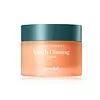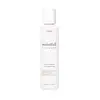What's inside
What's inside
 Key Ingredients
Key Ingredients

 Benefits
Benefits

 Concerns
Concerns

No concerns
 Ingredients Side-by-side
Ingredients Side-by-side

Prunus Armeniaca Fruit Extract
Skin ConditioningGlycerin
HumectantDimethicone
EmollientCaprylic/Capric Triglyceride
Masking1,2-Hexanediol
Skin ConditioningCetyl Ethylhexanoate
EmollientNiacinamide
SmoothingPolyglyceryl-3 Methylglucose Distearate
EmulsifyingCyclohexasiloxane
EmollientCetearyl Alcohol
EmollientButyrospermum Parkii Butter
Skin ConditioningCocos Nucifera Oil
MaskingEclipta Prostrata Extract
Skin ConditioningMelia Azadirachta Flower Extract
Skin ConditioningMelia Azadirachta Leaf Extract
Skin ConditioningCurcuma Longa Root Extract
MaskingOcimum Sanctum Leaf Extract
Skin ConditioningCorallina Officinalis Extract
Skin ConditioningMoringa Oleifera Seed Oil
EmollientPrunus Armeniaca Fruit Water
MaskingSoluble Collagen
HumectantGlyceryl Stearate
EmollientPentylene Glycol
Skin ConditioningCyclopentasiloxane
EmollientCetearyl Olivate
Sorbitan Olivate
EmulsifyingPolymethylsilsesquioxane
Hydroxyethyl Acrylate/Sodium Acryloyldimethyl Taurate Copolymer
Emulsion StabilisingTromethamine
BufferingHydroxyacetophenone
AntioxidantDimethiconol
EmollientWater
Skin ConditioningPanthenol
Skin ConditioningAdenosine
Skin ConditioningHydrogenated Rice Bran Oil
Skin ConditioningSodium Phytate
Sorbitan Isostearate
EmulsifyingHydrogenated Lecithin
EmulsifyingPolyglyceryl-10 Stearate
Skin ConditioningPropanediol
SolventGlyceryl Stearate Citrate
EmollientGlyceryl Caprylate
EmollientGlycogen
HumectantInositol
HumectantTrehalose
HumectantBehenyl Alcohol
EmollientCarbomer
Emulsion StabilisingXanthan Gum
EmulsifyingPrunus Armeniaca Fruit Extract, Glycerin, Dimethicone, Caprylic/Capric Triglyceride, 1,2-Hexanediol, Cetyl Ethylhexanoate, Niacinamide, Polyglyceryl-3 Methylglucose Distearate, Cyclohexasiloxane, Cetearyl Alcohol, Butyrospermum Parkii Butter, Cocos Nucifera Oil, Eclipta Prostrata Extract, Melia Azadirachta Flower Extract, Melia Azadirachta Leaf Extract, Curcuma Longa Root Extract, Ocimum Sanctum Leaf Extract, Corallina Officinalis Extract, Moringa Oleifera Seed Oil, Prunus Armeniaca Fruit Water, Soluble Collagen, Glyceryl Stearate, Pentylene Glycol, Cyclopentasiloxane, Cetearyl Olivate, Sorbitan Olivate, Polymethylsilsesquioxane, Hydroxyethyl Acrylate/Sodium Acryloyldimethyl Taurate Copolymer, Tromethamine, Hydroxyacetophenone, Dimethiconol, Water, Panthenol, Adenosine, Hydrogenated Rice Bran Oil, Sodium Phytate, Sorbitan Isostearate, Hydrogenated Lecithin, Polyglyceryl-10 Stearate, Propanediol, Glyceryl Stearate Citrate, Glyceryl Caprylate, Glycogen, Inositol, Trehalose, Behenyl Alcohol, Carbomer, Xanthan Gum
Water
Skin ConditioningHydrolyzed Collagen 18.68%
EmollientGlycerin
HumectantPropanediol
SolventPentaerythrityl Tetraethylhexanoate
EmollientMethyl Trimethicone
Skin ConditioningHydrogenated Poly(C6-14 Olefin)
Emollient1,2-Hexanediol
Skin ConditioningButylene Glycol
HumectantCetyl Ethylhexanoate
EmollientC14-22 Alcohols
Emulsion StabilisingGlyceryl Stearate Citrate
EmollientHydroxyethyl Acrylate/Sodium Acryloyldimethyl Taurate Copolymer
Emulsion StabilisingArachidyl Alcohol
EmollientGlyceryl Stearate
EmollientCarbomer
Emulsion StabilisingXanthan Gum
EmulsifyingC12-20 Alkyl Glucoside
EmulsifyingBehenyl Alcohol
EmollientGlyceryl Caprylate
EmollientTromethamine
BufferingArachidyl Glucoside
EmulsifyingDisodium EDTA
Ethylhexylglycerin
Skin ConditioningSorbitan Isostearate
EmulsifyingHydrolyzed Lupine Protein
Skin ConditioningGlucose
HumectantTocopherol
AntioxidantWater, Hydrolyzed Collagen 18.68%, Glycerin, Propanediol, Pentaerythrityl Tetraethylhexanoate, Methyl Trimethicone, Hydrogenated Poly(C6-14 Olefin), 1,2-Hexanediol, Butylene Glycol, Cetyl Ethylhexanoate, C14-22 Alcohols, Glyceryl Stearate Citrate, Hydroxyethyl Acrylate/Sodium Acryloyldimethyl Taurate Copolymer, Arachidyl Alcohol, Glyceryl Stearate, Carbomer, Xanthan Gum, C12-20 Alkyl Glucoside, Behenyl Alcohol, Glyceryl Caprylate, Tromethamine, Arachidyl Glucoside, Disodium EDTA, Ethylhexylglycerin, Sorbitan Isostearate, Hydrolyzed Lupine Protein, Glucose, Tocopherol
 Reviews
Reviews

Ingredients Explained
These ingredients are found in both products.
Ingredients higher up in an ingredient list are typically present in a larger amount.
1,2-Hexanediol is a synthetic liquid and another multi-functional powerhouse.
It is a:
- Humectant, drawing moisture into the skin
- Emollient, helping to soften skin
- Solvent, dispersing and stabilizing formulas
- Preservative booster, enhancing the antimicrobial activity of other preservatives
Behenyl Alcohol is a type of fatty alcohol (these are different from the drying, solvent alcohols).
Fatty Alcohols have hydrating properties and are most often used as an emollient or to thicken a product. They are usually derived from natural fats and oils; behenyl alcohol is derived from the fats of vegetable oils.
Emollients help keep your skin soft and hydrated by creating a film that traps moisture in.
In 2000, Behenyl Alcohol was approved by the US as medicine to reduce the duration of cold sores.
Learn more about Behenyl AlcoholCarbomer is a polymer of acrylic acid. Its main role is to create a gel consistency.
A high amount of carbomer can cause pilling or balling up of products. Don't worry, most products contain 1% or less of carbomer.
Cetyl Ethylhexanoate is an emollient ester. It comes from cetearyl alcohol and 2-ethylhexanoic acid.
Cetyl Ethylhexanoate is an emollient that adds a velvety feel to skin without being greasy or oily. Emollients help trap moisture into your skin, keeping your skin soft and hydrated.
Glycerin is already naturally found in your skin. It helps moisturize and protect your skin.
A study from 2016 found glycerin to be more effective as a humectant than AHAs and hyaluronic acid.
As a humectant, it helps the skin stay hydrated by pulling moisture to your skin. The low molecular weight of glycerin allows it to pull moisture into the deeper layers of your skin.
Hydrated skin improves your skin barrier; Your skin barrier helps protect against irritants and bacteria.
Glycerin has also been found to have antimicrobial and antiviral properties. Due to these properties, glycerin is often used in wound and burn treatments.
In cosmetics, glycerin is usually derived from plants such as soybean or palm. However, it can also be sourced from animals, such as tallow or animal fat.
This ingredient is organic, colorless, odorless, and non-toxic.
Glycerin is the name for this ingredient in American English. British English uses Glycerol/Glycerine.
Learn more about GlycerinGlyceryl Caprylate comes from glycerin and caprylic acid, a fatty acid from coconut. It has emollient and emulsifier properties.
As an emollient, it helps hydrate your skin. Emollients work by creating a barrier on your skin to trap moisture in, helping to keep your skin soft and smooth.
On the other hand, emulsifiers prevent ingredients (such as oil and water) from separating.
Learn more about Glyceryl CaprylateGlyceryl Stearate is a mix of glycerin and stearic acid.
It is used to stabilize the mixing of water and oil ingredients. By preventing these ingredients from separating, it can help elongate shelf life. It can also help thicken the product's texture.
As an emollient, it helps soften skin and supports barrier-replenishing ingredients.
In cosmetics, Glyceryl Stearate is often made from vegetable oils or synthetically produced.
This ingredient may not be fungal-acne safe
Fun fact: The human body also creates Glyceryl Stearate naturally.
Learn more about Glyceryl StearateGlyceryl Stearate Citrate is a citric acid ester of glyceryl stearate.
It is an emulsifier, emollient, and a surfactant.
Emulsifiers help stabilize a product. It does this by preventing certain ingredients from separating. Common ingredients include oils and water, which do not mix naturally. Emulsifiers have properties that help keep ingredients such as these together.
Emollients help soothe and soften the skin. They do this by creating a protective film on your skin. This barrier helps trap moisture and keeps your skin hydrated. Emollients may be effective at treating dry or itchy skin.
Surfactants help gather oils, dirt, and other pollutants from the skin. This helps them to be easily rinsed away.
Learn more about Glyceryl Stearate CitrateThis is a synthetic polymer. It helps improve the texture of products by adding thickness and gel-like feel.
It is also an emulsifer, meaning it prevents ingredients such as oil and water from separating. It also helps evenly disperse other ingredients.
Propanediol is an all-star ingredient. It softens, hydrates, and smooths the skin.
It’s often used to:
Propanediol is not likely to cause sensitivity and considered safe to use. It is derived from corn or petroleum with a clear color and no scent.
Learn more about PropanediolSorbitan Isostearate is an emulsifer and cleaning agent. It is created from isostearic acid and sorbitol.
As an emulsifier, Sorbitan Isostearate prevents oils and water from separating.
Due to its isostearic acid base, it may not be safe for Malassezia or fungal acne.
Learn more about Sorbitan IsostearateTromethamine helps balance the pH and improve the texture of a product. It is synthetically created.
As an emulsifier, Tromethamine prevents oil and water ingredients from separating. This helps stabilize the product and elongate a product's shelf life. Tromethamine also makes a product thicker.
Tromethamine helps balance the pH level of a product. Normal pH level of skin is slightly acidic (~4.75-5.5). The acidity of our skin is maintained by our glands and skin biome. Being slightly acidic allows our skin to create an "acid mantle". This acid mantle is a thin barrier that protects our skin from bacteria and contaminants.
Oral Tromethanmine is an anti-inflammatory drug but plays the role of masking, adding fragrance, and/or balancing pH in skincare.
1,3-Propanediol, 2-amino-2-(hydroxymethyl)-
Learn more about TromethamineWater. It's the most common cosmetic ingredient of all. You'll usually see it at the top of ingredient lists, meaning that it makes up the largest part of the product.
So why is it so popular? Water most often acts as a solvent - this means that it helps dissolve other ingredients into the formulation.
You'll also recognize water as that liquid we all need to stay alive. If you see this, drink a glass of water. Stay hydrated!
Learn more about WaterXanthan gum is used as a stabilizer and thickener within cosmetic products. It helps give products a sticky, thick feeling - preventing them from being too runny.
On the technical side of things, xanthan gum is a polysaccharide - a combination consisting of multiple sugar molecules bonded together.
Xanthan gum is a pretty common and great ingredient. It is a natural, non-toxic, non-irritating ingredient that is also commonly used in food products.
Learn more about Xanthan Gum